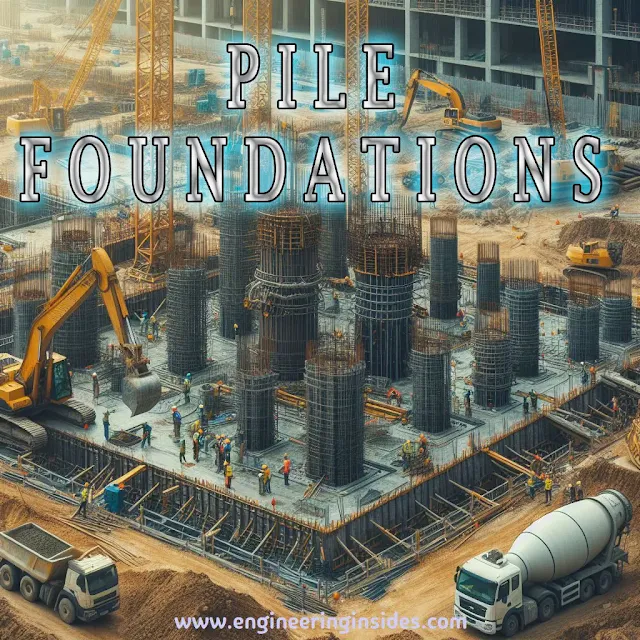In civil engineering, pile foundations acts as essential
structures to support various types of constructions such as bridges and
skyscrapers. In this article we’ll discuss the pile foundations, their types,
materials, load transfer mechanisms, design considerations, and construction
techniques.
Types of Pile Foundations
Pile foundations come in several types, each suited for
specific soil conditions and structural requirements:
1. Timber Piles
Timber piles,
typically made of circular or square seasoned wood, offer a cost-effective
solution for lightweight structures. However, their load-carrying capacity is
relatively low, and they are susceptible to decay if not kept below the water
table.
2. Concrete Piles
Concrete piles,
available as precast or cast-in-situ, provide greater load-bearing capacity and
resistance to environmental factors compared to timber piles. Precast concrete
piles are manufactured in factories, while cast-in-situ piles are formed
on-site by boring holes and filling them with concrete.
3. Steel Piles
Steel piles,
including rolled steel sections, tubes, or fabricated boxes, are suitable for
bearing piles due to their high strength. They are particularly useful for
driving close to existing structures with minimal soil disturbance.
4. Composite Piles
Composite piles
combine materials like concrete and timber or concrete and steel to leverage
the advantages of each material. They offer versatility and strength, making
them suitable for diverse soil conditions.
Classification According to Load Transfer Mechanisms
Piles are classified based on how they transfer loads to the
soil:
1. Bearing Piles
Bearing piles
transmit loads to hard strata beneath the soil through direct bearing. They are
preferred when a stable foundation can be achieved at a reasonable depth.
2. Friction Piles
Friction piles rely
on the frictional resistance between the pile surface and surrounding soil to
transfer loads. They are employed when hard strata are not accessible at
significant depths, requiring careful assessment of frictional forces for
optimal design.
Design Considerations for Pile Foundations
Designing pile foundations involves several critical
considerations to ensure structural integrity and stability:
1. Pile Cap Footings
Pile foundations
are typically capped with reinforced concrete slabs, known as pile cap
footings, to distribute loads evenly among piles. Reinforcement should be
placed adequately above the pile tops, and the pile cap should have a minimum
thickness as per building codes.
2. Location and Alignment
Piles should be
strategically located to align with the centroid of the pile cluster and the
center of gravity of column loads. While precise alignment may not always be
feasible during construction, adjustments may be necessary to meet design
specifications.
3. Load Distribution
The load
distribution among piles within a cluster must be carefully analyzed to ensure
each pile carries its designated share of the load. Factors such as pile
diameter and location relative to critical sections influence load
distribution.
Construction Techniques for Pile Foundations
Constructing pile foundations requires meticulous planning
and execution to achieve desired structural outcomes:
1. Pile Driving or Installation
Piles are driven
into the soil using various methods, including impact hammers, vibratory
drivers, or hydraulic presses, depending on soil conditions and pile materials.
Care must be taken to prevent damage to the piles during installation.
2. Concrete Placement
For cast-in-situ
concrete piles, boring holes are first formed in the soil, followed by the
placement of reinforcement cages and concrete. Special techniques, such as
under reaming, may be employed to enhance load-carrying capacity.
FREQUENTLY ASKED QUESTIONS
What are the primary types of pile foundations?
Pile foundations
are primarily classified into timber piles, concrete piles, steel piles, and
composite piles, each offering distinct advantages and applications.
How do bearing piles differ from friction piles?
Bearing piles
transfer loads to hard strata through direct bearing, while friction piles rely
on frictional resistance between the pile surface and surrounding soil for load
transfer, making them suitable for different soil conditions.
What factors should be considered during the design of
pile foundations?
Design
considerations for pile foundations include pile cap footings, location and
alignment of piles, load distribution among piles, and adherence to building
codes and standards.
What construction techniques are employed for pile
foundations?
Pile foundations
are constructed using various methods such as pile driving or installation,
concrete placement for cast-in-situ piles, and reinforcement techniques to
enhance load-carrying capacity.


